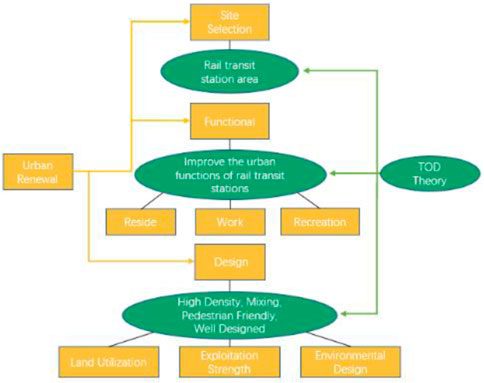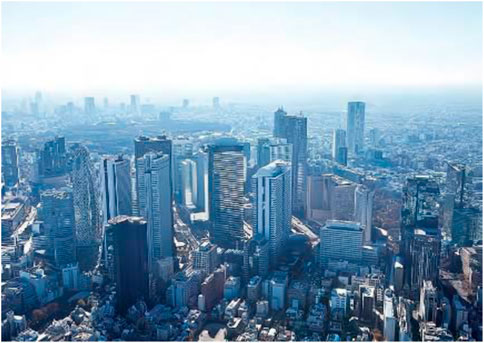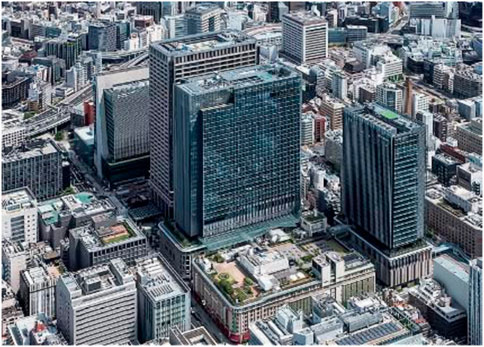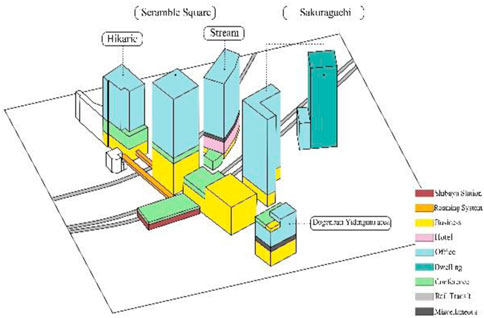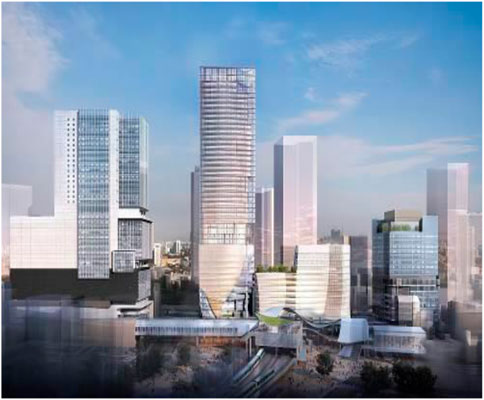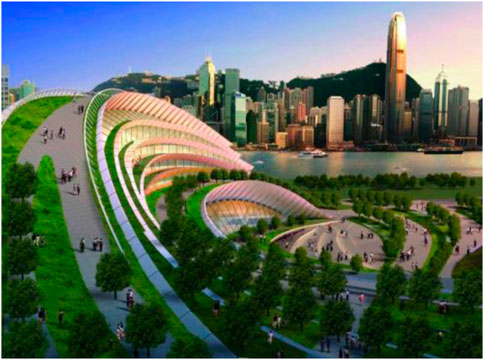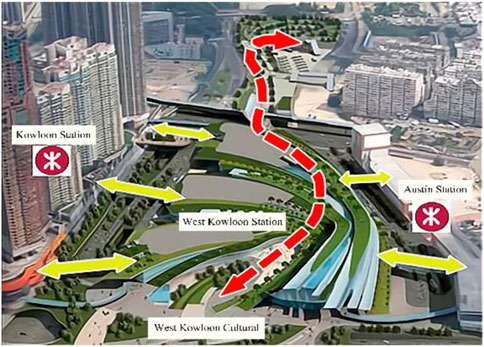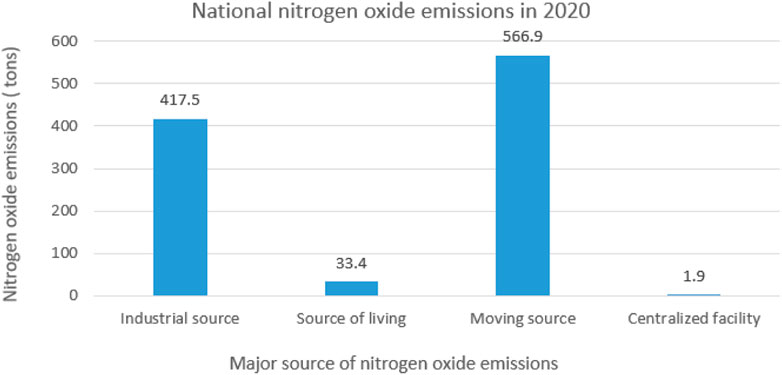- College of Civil Engineering and Architecture, Shandong University of Science and Technology, Qingdao, China
In the wake of decreasing urban development space in China, urban regeneration has gradually changed from incremental renewal to stock renewal. Looking back on the past development process of urban renewal, we can find that “Transit-oriented Development” (TOD) plays an essential role in modern urban renewal. Therefore, in this study, we explain the concept and principles of TOD and discuss the logic of TOD and urban renewal. In addition, we summarize the basic features of urban renewal strategy based on the TOD concept through the analysis of TOD cases to provide some ideas for future urban renewal work.
1 Introduction
Amid China’s economic and social development and the urbanization boost, cities have accommodated a large number of people, and the built-up area of cities has reached an unprecedented size. Consequently, the increasing shortage of limited resources, such as land and space for urban development has become a shackle to the better and faster development of major cities, and the unorderly spreading of big cities has also caused many urban issues. The Ministry of Housing and Urban-Rural Development (MOHURD) of China released the “Implementation of Urban Renewal Action” in November 2020 and announced the list of the first batch of pilot cities (districts) for urban renewal in November 2021. It is proposed to promote urban renewal and improve regional competitiveness through zoning adjustment, old city transformation, and establishment of new districts, which is gradually becoming a crucial topic in the new round of urban construction and common concern in all sectors of society.
In terms of urban renewal strategy, rail transit, as a catalyst for urban renewal, yields new ideas and impetus to the development of stock planning and urban renewal. By studying the history of rail transit construction and development, we find that the improvement of transportation conditions is the key to the success or failure of urban renewal, and rail transit is an important way to realize the optimization of urban spatial structure, coordinated land development, and urban redevelopment. From the current situation of urban transportation development in China, the role played by rail transit construction is not only limited to optimizing the urban public transportation system, increasing the proportion of public transportation travel, and reducing environmental pollution, but more importantly, can be utilized to promote the integrated development of the area near the station, optimize the urban spatial pattern, and drive the internal optimization and renewal of the city.
2 Historical process of urban renewal
The concept of urban renewal first originated in Western countries, and refers to the necessary and orderly transformation of built-up areas that do not meet the functional needs of modern cities in the process of urban development and construction. This includes demolition and reconstruction, functional transformation, comprehensive renovation and protection, and other ways (Lv and Zhao, 2009; Du and Tian, 2015). Since the 1950s, urban centers in some Western developed countries have experienced environmental degradation, traffic congestion, economic decline, and other problems. The population in urban centers began to migrate to the suburbs, and the population density continued to decline, resulting in serious “counterurbanization.” Many countries and scholars proposed the use of residential renewal, urban transformation, and redevelopment to restore the vitality of cities and change the trend of “counterurbanization” (Miller and Hoel, 2002; Sohn, 2005; Cervero and Murakami, 2008). The development of urban renewal as an effective means of solving urban problems can be divided into the following four stages under the influence of diverse situations.
2.1 Massive knockdown redevelopment and slum clearance
After World War II, a large-scale urban renewal movement was launched in Europe and the United States. Owing to the war, a large number of buildings were damaged and people’s living environment was poor. Local governments began to pay close attention to the living conditions of residents, and many cities formulated large-scale urban reconstruction and renovation plans. Under the guidance of the urban planning ideology advocated by Congrès Internationaux d'Architecture Moderne (CIMA) or International Congress of Modern Architecture at that time, which was characterized by “shape planning” and bulldozer reconstruction, many cities, such as London, Paris, and Berlin conducted a lot of demolition of old buildings in the city center and replaced them with various new “international” tall buildings (Ding and Wu, 2017). Meanwhile, several countries, represented by the United States, have also begun to focus on urban renewal to enhance the living environment. They conducted a series of slum clearance plans through large-scale demolition and clearance. The new look of the city, however, has become monotonous and inhumane, and has created a host of social problems that some Western scholars have called “the second destruction” (called the Second World War the first destruction).
2.2 Urban decline and neighborhood recovery
From 1950s to 1960s, post-war reconstruction was largely completed in Western countries, social work was steadily advancing, and economic development was entering a period of rapid growth. Due to the continuous high economic growth, the demand for land in the cities became increasingly high. At that time, the urban renewal movement was primarily focused on intensifying the use of land in the central areas of the cities, while a large number of residential houses and small and medium-sized businesses mixed with them were replaced by large commercial facilities and high-class offices in the urban fringe. In this context, the urban central area was once prosperous. The land price in the urban central area began to soar, the city continued to spread to the suburbs, the pressure of traffic congestion continued to increase, the attractiveness of the central area decreased, and many residents moved out. As a result,“counterurbanization” became increasingly serious. From 1960s to 1970s, the focus of urban renewal gradually shifted to the improvement of the community environment. Between 1960s and 1970s, the focus of urban renewal gradually shifted to the improvement of the community environment. Some middle-class families moved back to the city center from the suburbs and residents participated in the self-build of their neighborhoods, bringing new blood into the decaying neighborhoods.
2.3 Public participation and community planning
After the 1970s, urban renewal began to focus on integrated community regeneration. A social trend towards democratic pluralism emerged in some major Western countries, and a tripartite model of community, government, and private enterprise began to appear. The idea of public participation in planning, as an expression of “quasi-direct democracy,” began to be widely accepted by residents. Urban residents formed their organizations, committees, and associations to negotiate with the government and real estate developers to preserve their neighborhoods and lifestyles. Simultaneously, a bottom-up model of “community planning” began to emerge, which was a “voluntary renewal” spontaneously generated by the community. Residents desired to improve their living conditions while preserving the culture of their community. “Community planning” was small-scale and aimed to improve the environment, create jobs, and promote neighborhood harmony.
2.4 TOD model of urban renewal
After the 1990s, the “Transit-Oriented Development” model of urban renewal emerged to deal with traffic congestion, social class division, urban sprawl, and other issues. After years of practice and exploration, it has become the primary way of urban renewal in most countries. Life cycle assessment method provides important help to the coordinated development of society, economy and environment in the planning and implementation stage of a project. It provides important parameters for the development of urban renewal strategies by identifying and quantifying energy and material use and environmental emissions, evaluating the impact of these energy and material use and environmental emissions, and evaluating and implementing opportunities to influence environmental improvement.
The above four urban renewal stages have different focuses in terms of renewal mechanisms, objectives, and methods at different times (Table 1).
3 Challenges to urban renewal
The vigorous development and construction of urban rail transit has caused unlimited possibilities for the comprehensive development and utilization of land around the stations. However, in the actual urban renewal process, the operation of the projects still encountered many challenges.
3.1 Complexity of land tenure
In the historical process of urban renewal, the ownership relationship of building land in old urban areas is complex, and it may involve multiple subjects of property rights and use rights. Hence, it is interfered by different subjects of interests in such land preparation work related to urban renewal. Under the background of stock planning, the replacement of land property rights and the re-integration and re-use of land resources is the key to urban stock regeneration. Urban renewal work has to meet the demands of complex interest subjects for renewal as well as balance the division and coordination of interests of multiple interest subjects, which is a complex and difficult process. A successful renewal development model can achieve a win-win situation between the property rights and development subjects. The win-win situation needs to fully consider the needs of all stakeholders, and by establishing a hierarchical management and coordination mechanism that considers the interests of all parties, it is possible to eliminate the communication barriers between different interest subjects, and coordinate the interests, values, and functional needs of the public, land property users, government, and developers. This determines the process and direction of urban renewal to a large extent.
3.2 Deteriorating traffic conditions
The improvement of traffic conditions is an essential element of urban renewal. With economic development and social progress, more and more families have their cars, and the number of motor vehicles has proliferated over time, causing serious traffic congestion issues in various cities. Many historical problems left behind by urban development are also important factors causing traffic congestion at this stage. The traditional urban development model of wide roads and large districts has led to low density and poor accessibility of the existing road network. Especially in the old urban areas of city centers, the travel speeds during peak hours have decreased compared to previous years and the main roads are the primary cause of delays. Traffic congestion has become a major constraint on the economic, social, and environmental sustainability of cities in the long term. In the traditional urban renewal process oriented to small car traffic, it only stays at the relatively basic level of the construction and widening of main and secondary urban roads and the interconnection and repair of feeder roads, without considering the essential relationship between urban renewal and urban traffic conditions from the perspective of comprehensive urban land utilization, and spatial development pattern and form. The lack of a systematic understanding of urban traffic congestion has further worsened the congestion on urban roads.
3.3 Lack of social justice
Social equity in the sense of urban renewal does not arise from within the people but is a process of redistribution in top-level design and planning, which can also be understood as a process of eliminating “regional development imbalances.” However, this process cannot be fully achieved by individual residents and community organizations alone, especially in urban regeneration activities that aim at efficiency and speed, which can easily lead to a lack of social equity (Kirby, 2018). Many local governments, through urban renewal, have recreated the old built-up areas of the original cities, significantly improving the living environment and infrastructure conditions of the residents and attracting a large number of middle and high-income people to move in. However, simultaneously, the increased land value and rising housing prices have forced a large number of low-income residents to move out. Although some renewal projects have allocated a certain proportion of affordable housing to meet the needs of some low-income classes, this proportion is low and has little impact. The private car-oriented urban renewal development model has caused great expenditure and inconvenience to the daily life and employment of the low-income class without a car (Buitelaara and Cozzolino, 2019). For the urban renewal work of existing urban functional areas and communities along rail transit, if there is a lack of effective and complete feedback mechanism and low public participation in the initial stage of planning and design, it is difficult to protect the vital interests of the general residents, who are the most direct users of residential functional areas. Worse still, this will be unfair and unfavorable to the advancement of the project, and will also affect the cohesion among residents, management departments, and investors (Mueller, 2018).
3.4 Serious damage to the historic landscape
Protection and development is the eternal theme of urban renewal and renovation. The city’s strong historical and cultural landscape is an important part of its development momentum. Meanwhile, the development of the city provides considerable support for the protection of historical and cultural landscapes. From the material construction level, development is also for better protection. Only through a certain transformation and renovation can make urban development in line with the trend of the times to protect the historical and cultural landscape. In this sense, how to seek development in conservation and promote conservation with development is a critical part of good urban renewal work (Zhu and Chen, 2020). In the historical process of social development, the old city carries the culture and heritage of a city, and these historical and cultural features that have been baptized over the years are the soul of each city. In addition, these features have witnessed the evolution of the city and embody unique style and charm of the city, which is reflected in our psychological memory retained by the traditional historical and cultural features. Although some historical and cultural relics need to undergo some major and minor repairs with the loss of time, the fundamental physical format has not experienced fundamental changes. With the advancement of urban renewal and reconstruction, these cultural veins rooted in the depths of urban history are changing. Due to the lack of historical and cultural protection experience in many cities, massive historic and cultural relics have experienced huge damage, causing irreparable loss, although the large-scale demolition and reconstruction rapidly changed the appearance of the city (Liu, 2007; Zhuo, 2016).
3.5 Public space compression
With respect to the high-density built-up areas of old cities, their socio-economic structures, industrial patterns, and urban spatial forms are in urgent need of improvement. In the process of previous old city renewal and renovation, the industrial structure of some old built-up areas of cities has undergone a huge transformation. In particular, the traditional attributes of residential and cultural functions are gradually replaced by the commercial, office, and medical functions, and the public space, which is the physical carrier of cultural activities, is also gradually eroded in such renewal and renovation. Traditional neighborhoods are mostly human-scaled, while in the process of car-oriented urban renewal, the surge in the number of private cars has caused serious traffic congestion. To solve this problem, roads are inappropriately widened and newly built during the renewal and renovation process to accommodate the use of more cars. Such a chain reaction further exacerbates the shortage of urban public space. In addition, in some regeneration projects, due to the profit-seeking behavior of developers, who prefer those commercial and residential property projects with a high return value, a large number of public facilities and public open spaces are squeezed or even eliminated to maximize profits during the development and construction of the projects (Xu and Shao, 2014).
4 Urban renewal strategies based on the TOD concept
4.1 Concept and connotation of TOD
TOD advocates mixed, high-intensity, pedestrian-friendly development with public transit stops as the core area (Ding et al., 2013; Li et al., 2015). The concept of TOD has been around since before the 1990s, but it was not until Peter Calthorpe elaborated the TOD a model in detail in the book The next American Metropolis: Ecology-Community, and the American Dream Community, and the American Dream in 1993 that the concept was officially proposed for the first time (Calthorpe, 1993; Yang et al., 2020). The TOD model was first introduced as a response to the social and economic issues caused by urban sprawl in the United States. The core of its value is to build livable communities and promote sustainable urban development.
After years of research and practice, some basic principles regarding the TOD theory have been formed, the most representative of which are 3D and 5D principles. Robert Cervero and Kara Kockelman introduced the classic 3D theory (Diversity, Density, Design) after studying urban renewal in the San Francisco Bay Area (Cervero and Kockelman, 1997). The 3D theory has been taken as a guideline to provide a theoretical basis for the renewal and redevelopment of high-density old urban built-up areas (Niu, 2018). Subsequently, the 5D principle proposed by Robert Cervero was widely recognized by theoretical researchers and urban planners. The 5D principle includes density, that is, to increase the density of land development around the station as the core to improve the utilization of land and provide sufficient passenger flow for rail transit; distance, that is, the development and utilization of land around the station should be defined within a reasonable walking range, generally no more than 500 m, to ensure the comfort of walking; diversity, that is, the TOD community built with the bus station as the core contains a variety of land types and urban functions to meet the daily needs of people and reduce the proportion of motor vehicles (Ren, 2010; Ding et al., 2015); design, that is, the TOD area has good environmental design quality and a walkable roaming network system; destination accessibility, that is, the accessibility and convenience of public transportation for residents around the community should be high enough to reduce the dependence of residents on cars for travel.
4.2 Coordination between the TOD model and urban renewal
4.2.1 Coordination of development concepts
Along with the continuous development and evolution of public policy on urban renewal, the concept of renewal has taken more account of social equity. The original single value orientation driven by economic interests has gradually changed to harmonization of economic, social, and environmental values. The development concept and value orientation of urban renewal and TOD have reached an agreement (Figure 1), that is, to improve the spatial and environmental quality of cities, promote healthy and sustainable urban development, and let urban residents enjoy better living services.
4.2.2 Coordination of the interests of the subjects of rights
The process of urban renewal involves many stakeholders, such as community residents, city government, and developers, and different stakeholders have different interest demands. The smooth promotion and completion of an urban renewal project need to meet the interest demands of these three parties simultaneously. The urban renewal model based on the TOD concept can achieve the harmonization of the interests of all parties, which can significantly increase the value of the land before and after the development, and effectively solve the problem of government fund shortage due to the high cost of the renewal, the specific impact of land price is shown in Table 2 below. Developers can protect their commercial profits through measures, such as high-intensity development of the land, obtaining floor area ratio (FAR), and saleable floor area incentives from the government; To a large extent, urban renewal work also meets the demands of community residents for improving the quality of community space and environment, increasing public facilities and supporting facilities, and enriching community functions (Mo, 2021).
4.2.3 Coordination of design concerns
Urban renewal and TOD are coordinated and unified in their focus on urban development issues, such as alleviating traffic congestion, building roaming systems, and designing public spaces. In the process of urban renewal, all planning and design should serve the goal of prioritizing public transportation. Additionally, it is necessary to reorganize the inner connection between the public transportation system, urban service function, and urban development space, actively conduct systematic renewal and redevelopment around urban rail transit, and reasonably adjust the proportion and service target of rail transit. Meanwhile, we should pay more attention to the demands of urban residents for public space, strengthen the design of urban public spaces, implant more high-quality public spaces of appropriate scale in urban development areas, and link these public activity places through the construction of pedestrian roaming systems. Thereby, community residents can interact with nature and thus obtain a richer urban life experience.
4.3 Urban renewal based on the TOD concept
4.3.1 Urban land intensification
Influenced by economic and social development, technological progress, and other historical factors, the development density and utilization efficiency of urban land in the past were relatively low, making it difficult to give full play to land benefits. In the process of urban renewal, mixed and high-intensity land development is conducted around rail transit stations and within the radius of their influence, and the development mode is constantly changing from a single simple horizontal construction layout to a three-dimensional development direction, which is conducive to creating a sparse and staggered urban spatial pattern in old cities and maximizing the agglomeration effect of land development (Tu et al., 2021). After the Tokyo Olympic Games, the pace of urban development in Tokyo significantly increased, and the functional layout of some traditional urban centers, such as Marunouchi, Toranomon, and Otemachi could no longer meet the daily needs of the residents. Hence, the Tokyo Metropolitan Government began to formulate plans for the development of sub metropolitan core areas through urban renewal and Shinjuku and Kiyoshi etsumu areas with developed rail transit were listed as major renovation projects (refer to Figures 2, 3). Through the relocation of the Yodobashi Water Purification Plant near Shinjuku Station, a large area of developable building land was made available for the renewal of the Shinjuku sub-metropolitan core area. These sites have good foundation conditions that are ideal for the construction of super high-rise buildings. With the successful construction of the Keio Plaza Hotel, Shinjuku Mitsui Building, Tokyo Government Office Building, etc., the Shinjuku Super Tall Building site was created to meet the needs of local urban development. The Nihonbashi 2-Chome Urban Redevelopment Project was completed in 2019 under the “Special Urban Regeneration District” system established by the Japanese government. In an area of approximately 4.8 hm2 with an average FAR of approximately 7.55, the comprehensive development with an average FAR of up to 14 has been realized, which has become a typical successful case of intensive land use under the TOD model.
4.3.2 Complexity of urban functions
In the process of traditional urban development, the buildings built were given relatively single functions and attributes, which can independently realize their exclusive functions without interfering with each other. Urban residential areas are connected through roads, squares, and other links. Shopping malls and hotels have become an important way and place for people to live a social life. After the introduction of rail transit into the urban central area for urban renewal, the urban development structure with the station as the core was formed. In addition, three-dimensional and complex urban functions were organized in the area around the station, and the various urban functions work closely together and stimulate each other, such that the building takes on a networked and complex form from the original single urban function. As the most important traffic hub in Tokyo, the Shibuya Station plays an essential role in traffic dispersion, and the surrounding area is prosperous for business and entertainment, and thus the Tokyo Metropolitan Government designated the renewal of Shibuya Station as a special emergency construction area for urban regeneration (refer to Figures 4, 5). Its goal is to upgrade urban infrastructure and enhance the vitality and space for the development of Shibuya Station through the integration and introduction of high-level functional businesses (commercial functions, cultural exchange functions, community service functions, creative industry service functions, international business service functions, etc.) (Zhou and Kong, 2022). The Shibuya HIKARIE project, a TOD complex at Shibuya Station, integrates the space around the subway maintenance section, bus lanes, and the Keio Inokashira Line to create a three-dimensional urban development space by integrating multiple urban functions around the city’s rail transit stations.
4.3.3 Greening and decarbonizing cities
The old city renewal based on the TOD concept pays more attention to the construction of the roaming network. It emphasizes the establishment of the three-dimensional pedestrian system within the station area and connects the pedestrian relationship between the station and the surrounding land (Peng et al., 2008). The fragmentation of the urban pedestrian system is fixed by rail transit through the construction of pedestrian bridges and underground corridors, which improve the accessibility of walking, increase the reliance of community residents on the rail transit hub complex, and realize a major shift from the car-oriented travel to the transit-oriented travel. Therefore, it is possible to reduce the number of cars and their frequency of use, thus significantly reducing urban carbon emissions, and guiding the city towards a green and sustainable development path. A free roaming system formed by the pedestrian networks and non-motorized paths links bus stops with surrounding public activity spaces and venues of different types and scales, which enhances the returnability of the city and enriches the urban experience gained by visitors on foot (Dai et al., 2022). West Kowloon Station is one of the representatives of TOD integrated transportation hubs in Hong Kong. The passenger concourse and platforms of West Kowloon Station are all set underground. Although the construction of this layout mode has increased the economic cost (see the Table 3 below), it has brought huge social and environmental benefits. More abundant public space can be obtained above the station, the area of the station square is approximately 9,000 m2, the green area of the square reaches 30,000 m2, and its roaming system extends above the station roof (Figures 6, 7). Therefore, good integration with the urban space has been achieved.
4.3.4 Greening and decarbonizing cities
The construction and development of rail transit can effectively reduce energy consumption, reduce the emission of nitrogen oxides and other pollution gases, and improve the quality of urban space environment. Compared with other transportation systems, the comprehensive energy consumption ratio of rail transit is about 1:5.7, and the unit energy consumption is 418 KJ less than that of buses and 2215 KJ less than that of private cars. According to the latest forecast value of China’s national economic development, every increase of 100 million people in rail transit volume can reduce fuel consumption by 31,000 tons, equivalent to 272 million yuan. The unit energy consumption of major means of transportation can be seen in Table 4 below. Data from the Ministry of Ecology and Environment show that from 2016 to 2020, the total nitrogen oxide emissions in China were about 10.197 million tons, of which the nitrogen oxide emissions from mobile sources were 5.669 million tons, accounting for 55.6% of the total nitrogen oxide emissions in China, ranking the first in total emissions (Figure 8). As the rail transit is driven by electric power system, it can greatly reduce the emission of air pollutants in urban areas, which is conducive to the sustainable development of the city. Table 5 shows the pollution level of atmospheric environment caused by unit traffic volume of major transportation modes (Investigation Group of High-speed Railways in Four West European Countries, 1998).
5 Conclusion
Traditional urban renewal faces many problems, such as complex land tenure, deteriorating traffic conditions, lack of social equity, destruction of historical landscape, and compression of public space. The TOD strategy has great potential to reshape urban space, improve environmental quality, increase road network density, alleviate traffic congestion, and intensive and economic development, enhance land use efficiency, enrich urban public space functions, ensure social equity, and coordinate slow-moving and motor transport systems to lead urban low-carbon, green, and sustainable development.
Author contributions
PD is mainly engaged in the construction and writing of article ideas; HF is mainly responsible for collecting data of typical cases; XY is mainly responsible for data analysis; SH is mainly responsible for photo editing; GF is mainly responsible for the collection of references; YW is mainly responsible for drawing the charts.
Conflict of interest
The authors declare that the research was conducted in the absence of any commercial or financial relationships that could be construed as a potential conflict of interest.
Publisher’s note
All claims expressed in this article are solely those of the authors and do not necessarily represent those of their affiliated organizations, or those of the publisher, the editors and the reviewers. Any product that may be evaluated in this article, or claim that may be made by its manufacturer, is not guaranteed or endorsed by the publisher.
References
Buitelaara, E., and Cozzolino, S. (2019). The (ir)relevance of economic segregation. Jane Jacobs and the empirical and moral implications of an unequal spatial distribution of wealth. Cities 91, 23–28. doi:10.1016/j.cities.2018.02.027
Calthorpe, P. (1993). The next American Metropolis: Ecology, community & the American Dream. New York: Princeton Architectural Press.
Cervero, R., and Kockelman, K. (1997). Travel demand and the 3Ds: Density, diversity, and design. Transp. Res. Part D Transp. Environ. 2, 199–219. doi:10.1016/S1361-9209(97)00009-6
Cervero, R., and Murakami, J. (2008). “Rail + property development: A model of sustainable transit finance and urbanism,” in Institute of transportation studies, research reports, working papers, proceedings.
Dai, P., Han, S., Yang, X., Fu, H., Wang, Y., and Liu, J. (2022). Analysis of the Factors Affecting the Construction of Subway Stations in Residential Areas. Sustainability 14, 13075. doi:10.3390/su142013075
Ding, C., Xie, B. L., and Wang, Y. W. (2013). Interactive relationship between urban arterial transit route and land use in TOD mode. J. South China Univ. Technol. Sci. Ed. 41 (2), 66–73.
Ding, C., Wu, G. L., and Lin, Y. Y. (2015). Analysis on the development background and process of TOD in the United States. City Plan. Rev. 39 (5), 89–96.
Ding, F., and Wu, J. (2017). The evolution of the concept and the practical connation in today’s society. Urban Plan. Forum 6, 87–95.
Du, K., and Tian, L. (2015). Urban renewal and regeneration of London: A perspective of global city. Urban Plan. Int. 30 (4), 41–45.
Investigation Group of High-speed Railways in Four West European Countries (1998). Investigation report on high speed rail way in four West European countries. Chin. Railw. 8 (6), 38–46.
Kirby, A. (2018). Jane Jacobs and the limits to experience. Cities 91, 17–22. S0264275117309848. doi:10.1016/j.cities.2018.01.021
Li, T., Shi, Y. T., and Fu, W. Y. (2015). Evolving TOD concept and its sinicization. Urban Plan. Int. 30 (3), 72–77.
Liu, L. (2007). Study on the mode of old city renewal and reconstruction oriented by bus. Nanking: Nanjing Forestry University.
Lv, X. B., and Zhao, R. Y. (2009). Thoughts over urban renewal system in Shen zhen. Urban Plan. Rev. 33, 57–60.
Miller, J. S., and Hoel, L. A. (2002). The ‘smart growth’debate: Best practices for urban transportation planning, Socio-Economic Plan. Sci. 36, 1–24. doi:10.1016/s0038-0121(01)00017-9
Mo, D. (2021). A brief analysis of typical cases and experiences of TOD model in America. Chongqing Archit. 20 (7), 16–18.
Mueller, A. L. (2018). Voices in the city. On the role of arts, artists and urban space for a just city. Cities 91, 49–57. doi:10.1016/j.cities.2018.04.004
Niu, S. F. (2018). Study on the built environment of rail transit station based on green TOD Concept. Guangzhou: Southwest Jiaotong University.
Peng, D., Qiong, J., and Yuliang, D. (2008). Discussion on the Development Pattern of the Traffic-oriented Urban Underground Complex [J]. Journal of Shandong University of Science and Technology (Natural Science) 27 (2), 4.
Ren, C. Y. (2010). An analysis on the BackGround and evolution of transit-oriented devepment in the USA. Urban Plan. Rev. 25 (4), 92–99.
Sohn, J. (2005). Are commuting patterns a good indicator of urban spatial structure? J. Transp. Geogr. 13, 306–317. doi:10.1016/j.jtrangeo.2004.07.005
Tu, H. J., Ye, J. Y., and Naoki, T. (2021). A research on the urban renewal of Tokyo under the guidance of TOD mode. World Archit. 11, 22–26.
Xu, L., and Shao, L. (2014). “Research on the integration mode of inventory optimization and TOD development,” in Urban and rural governance and planning reform -2014 China urban planning annual conference proceedings (05 urban traffic planning), 205–220.
Yang, J. W., Duan, Y., and Le, X. H. (2020). Land preparation under TOD strategy: Case studies of shanghai, shenzhen and dongguan. Urban Plan. Int. 35 (4), 124–130.
Zhou, L. J., and Kong, Q. (2022). The policy and practice of Japanese urban three-dimensional development. Urban Plan. Int. 2, 1–12.
Zhu, H., and Chen, Z. C. (2020). A study on the renovation and renewal strategy of the old city center under the concept of TOD: A case study of hubei project urban renewal in luohu District, Shenzhen city. Chin. Foreign Archit. 3, 87–90.
Keywords: urban renewal, TOD mode, strategy characteristics, land utilization, urban rail transport
Citation: Dai P, Fu H, Yang X, Han S, Fu G and Wang Y (2023) Exploring the urban renewal strategy based on transit-oriented development concept--A case study of Japan and Hong Kong. Front. Mater. 10:1098027. doi: 10.3389/fmats.2023.1098027
Received: 14 November 2022; Accepted: 21 February 2023;
Published: 09 March 2023.
Edited by:
Kunal Mondal, Idaho National Laboratory (DOE), United StatesReviewed by:
Arnab Bose, Boehringer Ingelheim, United StatesBarnali Ghatak, Jadavpur University, India
Copyright © 2023 Dai, Fu, Yang, Han, Fu and Wang. This is an open-access article distributed under the terms of the Creative Commons Attribution License (CC BY). The use, distribution or reproduction in other forums is permitted, provided the original author(s) and the copyright owner(s) are credited and that the original publication in this journal is cited, in accordance with accepted academic practice. No use, distribution or reproduction is permitted which does not comply with these terms.
*Correspondence: Xuxu Yang, eWFuZ3h1QHNkdXN0LmVkdS5jbg==
 Peng Dai
Peng Dai Hui Fu
Hui Fu
